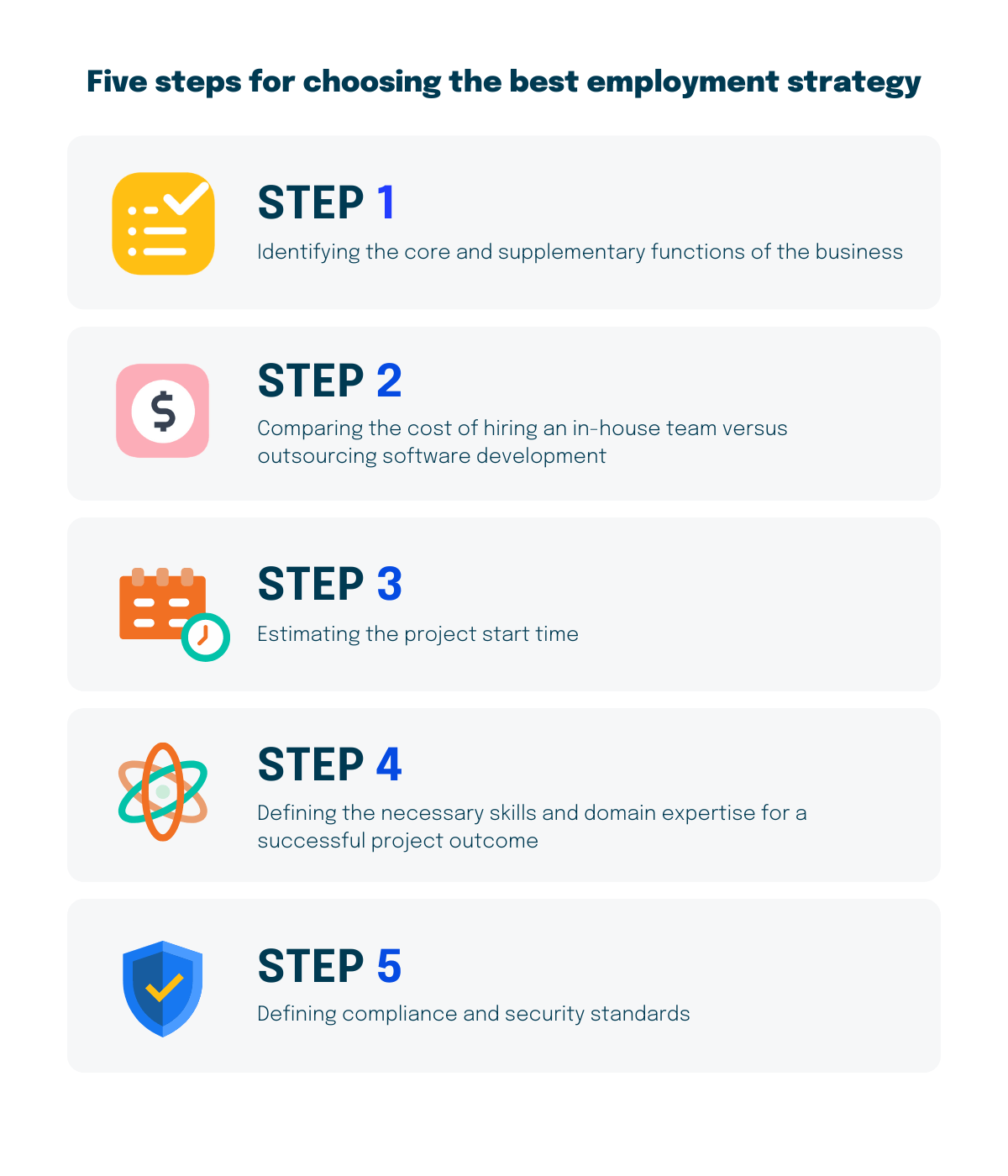In 1989, Peter Drucker predicted the “unbundling” of organizations and advocated the modern concept of outsourcing, calling it “support activities”. It all started as a way of cutting costs and headcounts — corporate payrolls needed trimming, but work still needed to be done. So why not send that work to an outsourced third party?
Outsourcing started with back-office admin functions, then spread into other areas such as customer services, manufacturing, and later, IT and software development. These days, IT outsourcing is big business. According to a Statista report, the global IT outsourcing market (including help and service desks) is expected to reach $587.30 billion by 2027, with a compound annual growth rate (CAGR) of 8.07%.
Regions such as Eastern Europe, because of its proximity to customers in Western Europe, and Mexico, because of its proximity to American and Canadian companies, are increasingly seen as popular destinations for IT outsourcing (also known as near-shoring). However, in some sectors, such as financial services, we are seeing a return to insourcing, which involves traditional in-house recruitment.
Table of Contents
Defining the differences between insourcing and outsourcing
There are two business practices for completing important projects or tasks in an organization:
- Insourcing: Assigning a project to a person or team within the company. This involves recruiting and employing specialists in-house to fulfill specific roles in the business, e.g., customer service, sales, graphic design, and software development.
- Outsourcing: Working with a freelancer, contractor, or outsourcing agency to perform specific tasks.
In other words, it comes down to whether you have or need to hire the in-house skills or whether you can find those skills outside the organization.
In this article, we will compare the pros and cons of outsourcing vs. insourcing for software development. We will also look at the hybrid approach and explore whether that is something companies should consider for software development projects.
Insourcing vs. outsourcing: How to choose the best option
1. Identify the core functions of the business
Every business has core and non-essential roles. For example, an insurance company needs actuaries and risk assessors. Insurance companies also need customer service teams and salespeople. All of these are essential to the operation of the business. Outsourcing any of these functions means one company is entrusting a core part of what makes them successful to another company, which is always risky.
However, an insurance company also needs reception staff, janitors, and other non-essential teams. Do they need to hire these in-house, or can they outsource? Since the late 80s, the argument has been to outsource that sort of work.
For many large corporations and small and medium businesses, software development stands between a “core” function and a non-essential function. Software engineering often plays a key operational and strategic role in the growth and service delivery plans. Even non-software organizations such as financial, healthcare, and insurance companies have chief technology and chief data officers. Behind those in senior management roles are internal teams that deliver on core objectives and outsourcing teams that work alongside them.
However, this hybrid approach may not be affordable for smaller companies. Therefore, the outsourcing model, from a cost perspective, may be the preferred route.
2. Compare the cost of hiring an in-house team vs. outsourcing software development
When you have an in-house team, you have to consider the following costs:
- Gross salary
- Tax and other mandatory government contributions
- Retirement contributions
- Office and IT costs
Companies should also take into account the recruitment and training costs, and the expenses of competing for the talent you need internally. If you are struggling to recruit for a specific role, then chances are your competitors are eager to hire those same skills, pushing salaries and other benefits that companies need to offer higher.
In contrast, when you outsource, you agree on a fixed hourly or monthly rate, with potential adjustments depending on flexible elements of the project/contract, and that’s it. The firm or individual you have partnered with is managing its own costs, such as office overhead and retirement contributions as a percentage of the payment agreed between both parties.
Software developers — especially those with several years of experience and niche skills in competitive fields (e.g., data scientists, DevOps engineers, and blockchain developers) — are in great demand. Recruiting the talent you need can be difficult. It is also worth questioning whether you need those skills in-house or if outsourcing would be a more effective solution.
Developing a complex software platform or product could require a team of five or more. Hiring in-house means determining the skills required, the right salaries to offer, recruiting the team, and paying those salaries for at least one year. Whereas, when you outsource, all of the recruitment work — and associated costs — have been taken care of by a third party. Once the project is complete, you’ve met your obligations.
Browse 500+ Dev Teams Available for Hire
3. Consider how urgent it is to get the project up and running
Going the traditional recruitment route takes time. You need to advertise a position and either work with a recruitment agency (which is an extra cost) or manage the process internally, which absorbs in-house resources. After that, you need to make job offers, onboard new staff, and move the project forward.
The recruitment process can take a few weeks to several months. However, star potential is not going to wait that long. Top talent will be snatched up by a competitor with a bigger budget or faster hiring process.
When it comes to hiring developers in-house, anyone who’s ever recruited them knows how competitive the landscape is. You are competing against big tech firms, other corporations, and high-growth startups. Your company is also restricted by geography. Most new hires come from within a commutable distance — in most cases, within an hour.
In comparison, outsourcing software development allows tapping into global tech talent — the professionals that wouldn’t ordinarily find your company are accessible and ready to work. The benefits of outsourcing are that you don’t have to wait months between making a decision to start a project and putting together a team to execute it. In some cases, you can assemble a qualified team ready to work on a project within two weeks.
4. Define the skill set required for your software development project
Expanding the team depends on the technology stack already in use, how the new application or platform is going to interact and integrate with that stack, and the skills you’ve already got onboard.
When hiring an internal team, you need to be sure you will need these skills for a long period of time (e.g., 6 to 12 months, at a minimum). If the scope of the project is not sufficient for them to be employed full-time over a prolonged period, you need to think about what skills would be useful for them to support others in the project or to work on other projects in the company.
If you are going to outsource software development to a technology team, you need to understand the scope and skills required clearly. For example, when hiring developers proficient in PHP and Node.js for software development, it is crucial to have a clear understanding of the project’s scope and required skills. Both PHP and Node.js offer robust frameworks and libraries for building scalable and efficient web applications.
The decision on scope should be made with the involvement and guidance of the internal technical lead — someone who can size up the project and bring the insight that translates business objectives into technical outputs. With this insight, you can hire a team of contractors that includes the most relevant and useful skills to deliver the required project outcomes.
Outsourcing software development is also the right solution when you need access to rare technologies. There are hundreds of programming languages and frameworks out there and, certainly, you can’t hire engineers who know all of them in-house.
5. Assess the risks
Outsourcing software development can bring many benefits to an organization. However, there are also some risks that need to be managed. When it comes to software and data, the biggest risks are the potential theft of project data and failure to comply with regulatory requirements (such as GDPR in Europe and PCI DSS). Quality control is another risk that companies worry about when outsourcing software development. How can they be sure that the work is up to the standards they require?
One way to mitigate and manage third-party risk is to vet an outsourcing partner. Make sure it’s a reputable company and that its developers have reliable references and are used to working with similar companies.
Insourcing can be a safer practice because you have more control over output quality and data transfer, ensuring compliance standards are met. However, that doesn’t mean things can’t go wrong. Disgruntled employees steal data, and internal systems fail, leading to data breaches.
So, now that we have gone over all the criteria, let’s take a quick look at the pros and cons of each and how it applies to different needs when looking for software developers.
| Criteria | Insourcing | Outsourcing |
| Is the hiring model suited for the core function? | Preferred for critical in-house positions that involve risk reduction and regulatory compliance. | Preferred for non-critical jobs that can be handled externally. |
| Hiring cost | In-house hiring involves paying salaries, taxes, pension contributions, and allocating expenses for recruitment, rent, and office equipment. | Outsourcing implies paying a fixed hourly or monthly rate, with possible adjustments depending on the project’s flexible elements. |
| Task urgency | Preferred for long-term projects but requires time and budget for team formation. | Prefered for quick project start, prevents overwhelming in-house developers with low-skill work, allowing more focus on strategic goals. |
| Skills needed | Preferred if skills align with core competencies are needed long-term. | Beneficial for non-core skills that are not essential in the long term, and when cost savings are a priority. |
| Risks involved with the hiring model | Insourcing is recommended for in-house risk management and task retention inside the in-house team. | Outsourcing is appropriate if a trustworthy provider is chosen and data security and compliance are not compromised. |
Hybrid approach: Combining internal and external expertise in software development
Sticking to one solution over another isn’t always the way forward, so you can take a hybrid approach. When you’ve got an internal software/IT team with a range of core skills, and then you need to augment those internal skills with more specialized experiences from a third-party, outsourcing software development to support the in-house team can be a smart and cost-effective move.
This gives your internal team the talent of an external provider for the duration of the project without the overhead and long-term costs associated with hiring additional internal team members. Your company gets the best of both worlds.
Key takeaways
Insourcing is better when recruiting for a set of skills aligned with other core competencies, and these skills will be needed in the long term. By investing the time and budget to build an internal team, you’ll get professionals who are deeply invested in the product, the company, and its culture. It is also a great option if you need more control over the quality of project output and secure data transfer.
On the other hand, outsourcing software development can be a more cost-effective solution if you need access to a wider talent pool without the risks associated with trying to recruit the talent that everyone else is scrambling to hire. In this case, the ramp-up of a software development project will be faster — you can have a dedicated team in as little as two weeks. Companies manage compliance and regulatory risks through vetting, contracts and the support of a trusted platform that verifies developers, and the agencies they work for.








